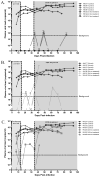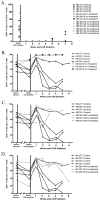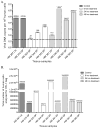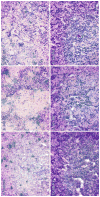Early Initiation of Antiretroviral Therapy Can Functionally Control Productive HIV-1 Infection in Humanized-BLT Mice
- PMID: 26167617
- PMCID: PMC4503390
- DOI: 10.1097/QAI.0000000000000687
Early Initiation of Antiretroviral Therapy Can Functionally Control Productive HIV-1 Infection in Humanized-BLT Mice
Abstract
Background: Recent reports showed that functional control of HIV-1 infection for a prolonged time is possible by early antiretroviral therapy (ART); however, its underlying mechanism needs to be studied with a suitable animal model. Recently, humanized-BLT (bone marrow, liver, and thymus) mouse (hu-BLT) was shown to be an excellent model for studying HIV-1 infection. We thus tested the feasibility of studying functional control of HIV-1 infection using hu-BLT mice.
Methods: Animals in 3 treatment groups (Rx-6h, Rx-24h, and Rx-48h) and untreated group were infected with HIV-1, followed by ART initiation at 6, 24, or 48 hours postinfection and continued daily for 2 weeks. Three weeks after stopping ART, CD8 T cells were depleted from all animals. Plasma viral load was monitored weekly using droplet digital polymerase chain reaction. Percentage of CD4 and CD8 T cells were measured by flow cytometry. In situ hybridization and droplet digital polymerase chain reaction were used to detect viral RNA (vRNA) and DNA.
Results: Although control animals had high viremia throughout the study, all Rx-6h animals had undetectable plasma viral load after ART cessation. After CD8 T-cell depletion, viremia increased and CD4 T cells decreased in all animals except the Rx-6h group. Viral DNA was detected in spleens of all animals and a few vRNA cells were detected by in situ hybridization in 1 of 3 Rx-6h animals.
Conclusions: Early ART did not act as prophylaxes but, rather, can control HIV-1 productive infection and prevented CD4 T-cell depletion in hu-BLT mice. This mouse model can be used to elucidate the mechanism for functional control of HIV-1.
Conflict of interest statement
Figures





Similar articles
-
Antiretroviral pre-exposure prophylaxis prevents vaginal transmission of HIV-1 in humanized BLT mice.PLoS Med. 2008 Jan 15;5(1):e16. doi: 10.1371/journal.pmed.0050016. PLoS Med. 2008. PMID: 18198941 Free PMC article.
-
Topical Tenofovir Disoproxil Fumarate Nanoparticles Prevent HIV-1 Vaginal Transmission in a Humanized Mouse Model.Antimicrob Agents Chemother. 2016 May 23;60(6):3633-9. doi: 10.1128/AAC.00450-16. Print 2016 Jun. Antimicrob Agents Chemother. 2016. PMID: 27044548 Free PMC article.
-
Efficient Inhibition of HIV Replication in the Gastrointestinal and Female Reproductive Tracts of Humanized BLT Mice by EFdA.PLoS One. 2016 Jul 20;11(7):e0159517. doi: 10.1371/journal.pone.0159517. eCollection 2016. PLoS One. 2016. PMID: 27438728 Free PMC article.
-
HIV-specific CD8⁺ T-cell immunity in humanized bone marrow-liver-thymus mice.J Infect Dis. 2013 Nov;208 Suppl 2(Suppl 2):S150-4. doi: 10.1093/infdis/jit320. J Infect Dis. 2013. PMID: 24151322 Free PMC article. Review.
-
Perspectives on Non-BLT Humanized Mouse Models for Studying HIV Pathogenesis and Therapy.Viruses. 2021 Apr 28;13(5):776. doi: 10.3390/v13050776. Viruses. 2021. PMID: 33924786 Free PMC article. Review.
Cited by
-
HIV-1 cellular and tissue replication patterns in infected humanized mice.Sci Rep. 2016 Mar 21;6:23513. doi: 10.1038/srep23513. Sci Rep. 2016. PMID: 26996968 Free PMC article.
-
High-fat diet feeding exacerbates HIV-1 rectal transmission.mSystems. 2024 Mar 19;9(3):e0132223. doi: 10.1128/msystems.01322-23. Epub 2024 Feb 2. mSystems. 2024. PMID: 38303112 Free PMC article.
-
Human Microglia Extensively Reconstitute in Humanized-BLT Mice With Human Interleukin-34 Transgene and Support HIV-1 Brain Infection.Front Immunol. 2021 May 21;12:672415. doi: 10.3389/fimmu.2021.672415. eCollection 2021. Front Immunol. 2021. PMID: 34093573 Free PMC article.
-
Smoothened Agonist Reduces Human Immunodeficiency Virus Type-1-Induced Blood-Brain Barrier Breakdown in Humanized Mice.Sci Rep. 2016 May 31;6:26876. doi: 10.1038/srep26876. Sci Rep. 2016. PMID: 27241024 Free PMC article.
-
Moving beyond the mousetrap: current and emerging humanized mouse and rat models for investigating prevention and cure strategies against HIV infection and associated pathologies.Retrovirology. 2020 Apr 10;17(1):8. doi: 10.1186/s12977-020-00515-3. Retrovirology. 2020. PMID: 32276640 Free PMC article. Review.
References
-
- Phongsamart W, Hansudewechakul R, Bunupuradah T, et al. Long-term outcomes of HIV-infected children in Thailand: the Thailand Pediatric HIV Observational Database. Int J Infect Dis. 2014 Feb 25; - PubMed
-
- UNAIDS. Global report: UNAIDS report on the global AIDS epidemic. 2013
-
- Hutter G, Nowak D, Mossner M, et al. Long-term control of HIV by CCR5 Delta32/Delta32 stem-cell transplantation. N Engl J Med. 2009 Feb 12;360(7):692–698. - PubMed
Publication types
MeSH terms
Substances
Grants and funding
LinkOut - more resources
Full Text Sources
Medical
Research Materials
Miscellaneous

